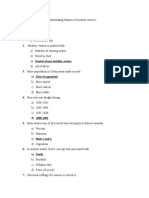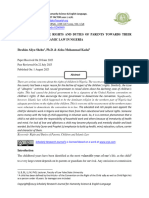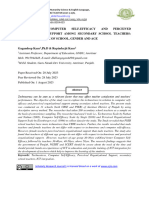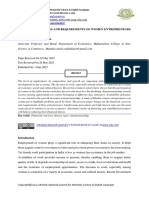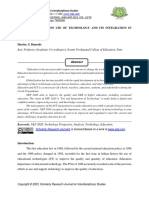Uncommon Writer: A Life of John Galsworthy
Uncommon Writer: A Life of John Galsworthy
Uploaded by
Anonymous CwJeBCAXpCopyright:
Available Formats
Uncommon Writer: A Life of John Galsworthy
Uncommon Writer: A Life of John Galsworthy
Uploaded by
Anonymous CwJeBCAXpOriginal Title
Copyright
Available Formats
Share this document
Did you find this document useful?
Is this content inappropriate?
Copyright:
Available Formats
Uncommon Writer: A Life of John Galsworthy
Uncommon Writer: A Life of John Galsworthy
Uploaded by
Anonymous CwJeBCAXpCopyright:
Available Formats
Scholarly Research Journal for Interdisciplinary Studies,
Online ISSN 2278-8808, SJIF 2021 = 7.380, www.srjis.com
PEER REVIEWED & REFEREED JOURNAL, NOV-DEC, 2022, VOL- 10/74
UNCOMMON WRITER: A LIFE OF JOHN GALSWORTHY
Prof. Surekha Baburao Bhosle
Jr. Lecturer, Higher Secondary Ashram School, Chavanwadi, Tq. Mukhed, Dist. Nanded.
E-mail: bhoslesurekha123@gmail.com
Paper Received On: 25 DECEMBER 2022
Peer Reviewed On: 31 DECEMBER 2022
Published On: 01 JANUARY 2023
Scholarly Research Journal's is licensed Based on a work at www.srjis.com
John Galsworthy’s Life:
The English novelist and playwright John Galsworthy (1867-1933) was one of the
most popular writers of the early 20th century. His works explore the transitions and contrasts
between pre-and post world war I England. Born on August 14, 1867 in Kingston Hill in a
wealthy family, his ancestors came from Devonshire farming stock; but at the time of his
birth they had accumulated considerable property and also owned shipping business. His
father, also named John Galsworthy, was an established solicitor and company director in
London. He was quite charming and young Galsworthy used to idolize him. His mother,
Blanche Bailey Galsworthy, was very religious and at the same time very fussy. Junior
Galsworthy was the eldest son of his parents. He started his education under the tutors at
home and later was admitted to a preparatory school at Bournemouth at the age of nine. From
there he went to Harrow where he distinguished as an athlete. After passing out from Harrow
young John Galsworthy was admitted to new college oxford. In 1889, he passed out from
there with a degree in jurisprudence. In 1890, he was called to bar; but as he wanted to
specialize in marine law he joined his family’s shipping business and spent time travelling
around the world.
Galsworthy was born at what is now known as Galsworthy House (then called
Parkhurst) on Kingston Hill in Surrey, England, the son of John and Blanche Bailey (née
Bartleet) Galsworthy. His family was prosperous and well established, with a large property
in Kingston upon Thames that is now the site of three schools: Marymount International
School, Rokeby Preparatory School, and Holy Cross Preparatory School. He attended Harrow
Copyright © 2022, Scholarly Research Journal for Interdisciplinary Studies
Prof. Surekha Baburao Bhosle 17865
Pg. (17864-17872)
and New College, Oxford. He took a Second in Law (Jurisprudentia) at Oxford in 1889, then
trained as a barrister and was called to the bar in 1890. However, he was not keen to begin
practicing law and instead travelled abroad to look after the family's shipping business.
During these travels, he met Joseph Conrad in 1893, then the first mate of a sailing-ship
moored in the harbour of Adelaide, Australia, and the two future novelists became close
friends. In 1895 Galsworthy began an affair with Ada Nemesis Pearson Cooper (1864–1956),
the wife of his cousin Major Arthur Galsworthy. After her divorce ten years later, they were
married on 23 September 1905 and stayed together until his death in 1933. Before their
marriage, they often stayed clandestinely in a farmhouse called Wingstone in the village of
Manaton on Dartmoor, Devon. In 1908 Galsworthy took a long lease on part of the building,
and it was their regular second home until 1923.(1)
A love affair between John Galsworthy and Ada Nemesis Pearson Cooper began in
1895. This was in spite of the fact that she was the wife of his first cousin major Arthur
Galsworthy. For ten years they met clandestinely in a farmhouse in Devon. It is said that
Irene in The Forsyte Saga was modeled after Ada. The couple got married on September 23,
1905. After Ada’s divorce came through. They didn’t have any children and remained
together till his death in 1933. Galsworthy’s father passed away in 1904. He now inherited
his father’s estate and became financially independent. By now, he had also realized that he
was not fit for making a living out of law. He therefore, gave up his legal career and decided
to devote all his time to writing.
Career
From the Four Winds, a collection of short stories, was Galsworthy's first published
work in 1897. These and several subsequent works were published under the pen name of
John Sinjohn, and it was not until The Island Pharisees (1904) that he began publishing under
his own name, probably owing to the recent death of his father. His first full-length novel,
Jocelyn, was published in an edition of 750 under the name of John Sinjohn—he later refused
to have it republished. His first play, The Silver Box (1906) —in which the theft of a
prostitute's purse by a rich 'young man of good family' is placed beside the theft of a silver
cigarette case from the rich man's father's house by 'a poor devil', with very different
repercussions, though justice was clearly done in each case—became a success, and he
followed it up with The Man of Property (1906), the first book of a Forsyte trilogy. Although
he continued writing both plays and novels, it was as a playwright that he was mainly
appreciated at the time. Along with those of other writers of the period, such as George
Copyright © 2022, Scholarly Research Journal for Interdisciplinary Studies
Prof. Surekha Baburao Bhosle 17866
Pg. (17864-17872)
Bernard Shaw, his plays addressed the class system and other social issues, two of the best
known being Strife (1909) and The Skin Game (1920).
He is now far better known for his novels, particularly The Forsyte Saga, his trilogy
about the eponymous family and connected lives. These books, as with many of his other
works, deal with social class, and upper-middle class lives in particular. Although
sympathetic to his characters, he highlights their insular, snobbish, and acquisitive attitudes
and their suffocating moral codes. He is viewed as one of the first writers of the Edwardian
era who challenged some of the ideals of society depicted in the preceding literature of
Victorian England. The depiction of a woman in an unhappy marriage furnishes another
recurring theme in his work. The character of Irene in The Forsyte Saga is drawn from Ada
Pearson, though her previous marriage was not as miserable as that of the character.
Works
John Galsworthy was an English novelist and play writer who won the Noble Prize
for literature in 1932. In 1904 Galsworthy published his first novel under his own name.
Titled ‘The Island Pharisees’ the story is about an unusual young man called Richard Shelton.
Galsworthy considered this book to be one of this most important works. Two years later in
1906, Galsworthy published his First play Silver Box It depicts how different standards of
justice are applied to people belonging to different classes and how theft by a rich and poor
man attract different repercussion. It was much appreciated by the critics. In 1906 , he also
published ‘Man of Property’, which later included in his famous trilogy ‘The Forsyte Saga’.
Through this work. Galsworthy launched a scathing attack on upper middle class families, to
which he himself belonged. He then continued writing a number of novels, short stories and
plays.
The original PEN was founded in London in 1921 by the English novelist John
Galsworthy, and it has since grown to include writers worldwide. The name PEN is an
acronym standing for “poets, playwrights, editors, essayists, and novelists.”(2) International
PEN promotes international intellectual exchanges and goodwill among writers. It promotes
freedom of expression for all writers regardless of their nationality, race, or religion, or of the
political system under which they live. PEN is especially active in defending and supporting
writers who are being harassed, persecuted, or oppressed by their government. The
organization also bestows literary awards, sponsors translations of works written in obscure
or neglected languages, holds conferences on current politico-literary topics, and publishes
pamphlets and newsletters. To become a member of PEN an author must usually have
Copyright © 2022, Scholarly Research Journal for Interdisciplinary Studies
Prof. Surekha Baburao Bhosle 17867
Pg. (17864-17872)
published at least two books, one of which shows considerable literary distinction. PEN is
headquartered in London, and there are more than 80 PEN Centres (branch organizations)
situated in a total of about 60 countries worldwide.
Causes
Through his writings Galsworthy campaigned for a variety of causes, including prison
reform, women's rights, and animal welfare, and also against censorship. Galsworthy was a
supporter of British involvement in the First World War. In an article for The Daily News on
31 August 1914 Galsworthy called for war on Germany to protect Belgium. Galsworthy
added "What are we going to do for Belgium — for this most gallant of little countries,
ground, because of sheer loyalty, under an iron heel?"(3) During the First World War he
worked in a hospital in France as an orderly, after being passed over for military service, and
in 1917 turned down a knighthood, for which he was nominated by Prime Minister David
Lloyd George, on the precept that a writer's reward comes simply from writing itself.
Galsworthy opposed the slaughter of animals and fought for animal rights. He was
also a humanitarian and a member of the Humanitarian League. He opposed hunting and
supported the League for the Prohibition of Cruel Sports.
honour
Galsworthy was offered a knighthood in 1918, but he refused it. He was erroneously
awarded the rank in the published list when his letter declining the honour went astray, but he
was never given the accolade, and the honour was later withdrawn. In 1921 Galsworthy was
elected as the first president of the PEN International literary club and was appointed to the
Order of Merit in 1929. He was awarded the 1932 Nobel Prize for Literature, having been
nominated that same year by Henrik Schück, a member of the Swedish Academy. He was too
ill to attend the Nobel Prize presentation ceremony on 10 December 1932, and died seven
weeks later. He donated the prize money from the Nobel Prize to PEN International.
Death
Galsworthy lived for the final seven years of his life at Bury in West Sussex. He died
from a brain tumour at his London home, Grove Lodge, Hampstead. In accordance with his
will he was cremated at Woking, with his ashes then being scattered over the South Downs
from an aeroplane, but there are also memorials to him in Highgate (West) Cemetery and in
the cloisters of New College, Oxford, cut by Eric Gill. The popularity of his fiction waned
quickly after his death, but the hugely successful black-and-white television adaptation The
Forsyte Saga in 1967 renewed interest in his work.
Copyright © 2022, Scholarly Research Journal for Interdisciplinary Studies
Prof. Surekha Baburao Bhosle 17868
Pg. (17864-17872)
Galsworthy lived far the final seven years of his life at Bury in west Sussex. He died
from a brain tamour at his Landon home Grove Lodge Hampstead. In accordance with his
will he was cremated at Woking. With his ashes them being scattered over the South Downs
from an aeroplane but there are also memorials to him in High gate ‘New cemetery and in the
cloisters of New college Oxford cut by Eric Gill. The Forsyte Saga in 1967 renewed interest
in his work. In 2007, Kingston University opened a new building named in recognition of
his local birth. Galsworthy Road in Kingston. The location of Kingston Hospital, is also
named for him.
“Galsworthy’s writing was summarily influenced by his surroundings and the people
who inhabited them. His childhood memories of coombe warren and the beautiful
surrounding countryside influenced his portrayal of Robin Hill in the Forsyte books. There
were the great many relatives in his life, and it is apparent that the extended Galsworthy clan
influenced the authors character constructs in the forsyte saga and several other novels.”(4)
His meeting with Joseph Conrad gave Galsworthy the idea of becoming a writer, but
the motivating force behind his writing was his wife, Ada. Her beauty and allure
Galsworthy’s smitten state, and her suggestion that he write propelled Galsworthy from bored
lawyer to energized writer. Moreover, her marital status in the Victorian era when marriage
was truly for life, her undeniable love for Galsworthy, her beauty, and her courage in entering
into an illicit relationship condemned by the society of which they were so much a part
proved subject and them for much of Galsworthy’s literary output over his lifetime. He was
too much influenced by his literary and historical contemporaries including Joseph Comrade.
The Forsyte Chronicles
1 The salvation of a Forsyle (1900)
2 On Forsyle Change (1930) (re-published 1986 as “Uncollected Forsyte”
3 Danae (1905-06) in forsytes, Pendyces, and other (1935)
4 The man of Property (1906) First book of The Forsyte Saga (1922)
5 The country House (1907)
6 “Indian Summer of a Forsyte” (1918) first interlude of The forsyte saga in five Tales
(1918)
7 In chancery (1920) – second book of The Forsyte saga
8 Awakening (1920)
9 To Let (1921)
10 The White Monkey (1924)
Copyright © 2022, Scholarly Research Journal for Interdisciplinary Studies
Prof. Surekha Baburao Bhosle 17869
Pg. (17864-17872)
11 The Silver Spoon (1926)
12 A Silent Wooing (1926)
13 Passer – By (1927)
14 Swan Song (1928)
15 Four Forsyte stories (1929)
“A sad Affair” “Dog at Timothy’s”
The Hondekoeter” and f’ midsummer madness”
16 Maid in Waiting (1931)
17 Flower Wilderness (1932)
18 One more River Coriginally over the River (1933)(5)
Plays
The Silver Box – (1906)
Strife – (1909)
Joy – (1909)
Justice – (1910)
The Little Dream. (1911)
The Pigeon – (1912)
The Eldest Son – (1912)
The Fugitive- (1913)
The Little man – (1915)
A Bit O’ Live – (1915)
The Foundation – (1920)
The Skin Game – (1920)
A Family man – (1922)
Loyalties – (1922)
Windows - (1922)
Escape – (1926)
Punch and Go – (1935)
ESSAYS:
Quality: - 1912, the Inn of Tranquility 1912, Addresses in America-1912, Two Essays
on Conrad – 1930
Collections:
The Manton Edition – 1923-26 (30 Vols.)
Copyright © 2022, Scholarly Research Journal for Interdisciplinary Studies
Prof. Surekha Baburao Bhosle 17870
Pg. (17864-17872)
The Grove Edition – 1927-34 (27 Vols.)
Features of Galsworthy’s Writing:
John Galsworthy as a Noble Laureate English novelist and playwright had been
known worldwide for his exceptionally vivid and critical style of writings. His quintessential
trait has been the criticism and a sympathetic portrayal of upper middle class Britons but in
doing so he never missed the humanist footing and wit in shaping his characters and plots.
The patrician John Galsworthy much like his unequalled masterpiece The Forsyte Saga
displays all these elements with ultimate depth lucidity and vividness. Reading John
Galsworthy is a revealing experience, but reading The patrician can be more revealing about
the harmony melancholy and critical depth author can achieve with his fluid and powerful
writing style.
As an author of an array of acclaimed literary works, Galsworthy in his lifetime
gained an astounding readership that even his crudest critics would hardly disagree with his.
As a novelist and a dramatist Galsworthy deals with the vital problems and sues in the social
cultural, religious and industrial life of the times without any partisanship though his
sympathies break out from time to time. His famous novel The Forsyte, the man of property
through two generations and in its large canvas it includes many facets of life and many
facets of characters. In his pictures and analysis of life and characters he has brought a keen
and searching observation, and ironical humour, sharp sensibility and a polished and urban
style to bear upon his subject. Forsyte saga is one of the best – sellers among modern English
fiction.
The impulse that guided him in the selection of subjects for his plays is perhaps best
explained in his own words : “The sociological character of my plays arises from the fact that
I do not divorce creation from life; that, living and moving, feeling and seeing amongst real
life, I find myself moved now and then-not deliberately and consciously-to present to myself
the types, the ideas, and juxtapositions of life that impinge on my consciousness, and clarify
all in the form of a picture.”(6)
John Galsworthy as a ‘Playwright’:
As a novelist and a dramatist and Galsworthy deals with the vital problems and issues
in the social cultural, religious and industrial life of the times without any partisanship though
his sympathies break out from time to time. In the dramas Galsworthy adopts the same
naturalistic technique in the tradition of Jones and Pinero. He was too, a great artist to deal
with problems from the stand point of a partisan and to after any solution of his own. He
Copyright © 2022, Scholarly Research Journal for Interdisciplinary Studies
Prof. Surekha Baburao Bhosle 17871
Pg. (17864-17872)
dissects them with an impartial and detached attitude, presents both sides of the cases without
passion or prejudice. The solution of the problem is not ‘obtruded’ but only hinted at. In this
respect Galsworthy differs from Shaw, who is primarily a propagandist. As Chesterton has
observed – “show cannot really divide his mind and let the two parts speak independently. If
we want to see a fair artistic balance between two opposite views, We must go to Ibsen or
Galsworthy”(7) Shaw writes as if firing a machine gun at his readers, Galsworthy as if
speaking with an equal in a cultivated prose style. “He looked upon the masses of humanity
as mostly victims of their own ignorance and folly and was content to reflect a social problem
which we must somehow endure, because there is not solution It must however be noted that
Shaw and Galsworthy are different in their artistic forms.”(8) Galsworthy is a tragedian, while
Shaw is a Comedian. Galsworthy creates tragic pity out of the clinical presentation of the
problems of modern men and women. Shaw is serious in his social and philosophical themes,
but he presents them in a light-hearted manner with humor, wit and fun. Shaw is a great
humorist and his art lies in presenting the ugly facts of life in the sugar coated pills of fun and
laughter. He is a greater thinker than Galsworthy and he is again a greater joker. Shaw is a
more powerful personality and influence in the twentieth century English Literature.
As a dramatist craftsman Galsworthy is superior to all other contemporaries and is a
contrast to Shaw. “The man of property (1906) began the novel sequence known as The
forsyte saga by which Galsworthy is chiefly remembered; others in the same series are
“Indian summer of a forsyte” 1918, in five Tales) , In chancery (1920) Awakening (1920)
and to let (1921). The saga chronicles the lives of three generations or a large upper middle-
class family at the turn of the century. Having recently risen to wealth and success in the
profession and business world, The Forsytes are tenaciously clannish and anxious to increase
their desire-For property is morally wrong. The saga intersperses diatribes against wealth
with lively passages describing character and background. Galsworthy was also a successful
dramatist his plays in a naturalistic style usually examining some controversial ethical or
social problem. They include the silver Box (1906), which like many of his works, has a legal
theme and depicts a bitter contrast of the law’s treatment of the rich and the poor. Strife
(1909) a study of industrial relations; Justice (1910) a realistic for trail or prison life that
aroused so much feeling that it led to reform; and loyalties (1922) the best of his later plays.
Galsworthy’s writings, by their abstention from complicated psychology and their
greatly simplified as faithful pattern of English life for a time. Galsworthy is remembered for
this evocation or Victorian and Edwardian upper middle-class life and for his creation of
Copyright © 2022, Scholarly Research Journal for Interdisciplinary Studies
Prof. Surekha Baburao Bhosle 17872
Pg. (17864-17872)
Soames Forsyte a dislikable character who nevertheless compels the reader’s sympathy. A
television serial of The Forsyte Saga by the British Broadcasting Corporation achieved
immense popularity in Great Britain in 1967 and later in many other nations especially the
United States reviving interest in an author whose reputation had plummeted after his death.
As a dramatist Galsworthy belongs to the realist tradition of Jones and Pinero. He says
himself in a magazine article. “Some platitudes concerning Drama” (9)
“Every grouping of life and character has its inherent moral. And the business of the
dramatist is so to pose the group as to bring that moral poignantly to the light or day,” (10) and
his plays are all didactic in purpose. Galsworthy was a social reformer objectively and
impartially posing a problem, showing always both sides of the question, and leaving his
audience to think out the answer. His chief protagonist are usually social forces in conflict
with each other, and the human concern in his drama, though real enough and very true to
ordinary life are studied more as individuals who are of interest for their own sake. To this
extent they are types.
References
Philips Hughes, Hollis and Carter, 42s: John Whit gift and English Reformation by Power Mills
Dawley, p. 17
Scribbleprint.com/literary/exploration of the social critic in the patrician by John ….. Quotes. Your
dictionary.com, https://www.english.org
Small, Ian (1984). "Special Collections Report: The Galsworthy Collection and Its Fate". English
Literature in Transition, 1880-1920. 27 (3): 236–238. ISSN 1559-2715
The Passive Mystique: we have been has Anthonywolk, p. 58
Education Law will circumvent unjust Hurdles inhered to the current structure. Britany L.Bane.2017
(Journal), p. 75-81
John Galsworthy: Strife A Drama in Three acts (2021), First Reprint, Indian Leather Complex,
15A/1, Golam Jilani Khan Road, Kolkata-700 039, p. 262
John Galsworthy: Justice A Tragedy in Four Acts (2021), First Reprint, Indian Leather Complex,
15A/1, Golam Jilani Khan Road, Kolkata-700 039, p. 232-233
Cherry, Bridget; Pevsner, Nikolaus (1983). The Buildings of England, London 2: South.
Harmondsworth, Middlesex, England: Penguin Books. ISBN 0-14-071047-7, p. 321
Oxford University Calendar 1895, Oxford: Clarendon Press, 1895, p. 262
Cooper, Robert M. (1998). The Literary Guide & Companion to Southern England. Ohio University
Press. ISBN 0-8214-1225-6. Retrieved 25 September 2008. p. 323–324.
Copyright © 2022, Scholarly Research Journal for Interdisciplinary Studies
You might also like
- Michael Madhusudan DuttDocument9 pagesMichael Madhusudan DuttGreen LightNo ratings yet
- English Writings of Rabindranath ThakurDocument5 pagesEnglish Writings of Rabindranath ThakurMr. Indranil Sarkar M.ANo ratings yet
- Poetry-Iii: Teacher: Abid Feroz Department of English Language and LiteratureDocument14 pagesPoetry-Iii: Teacher: Abid Feroz Department of English Language and LiteratureNaseeb khanNo ratings yet
- GRTJ P898.10 FDocument6 pagesGRTJ P898.10 FDisha GogoiNo ratings yet
- Andha Yug by Dharamvir BharatiDocument13 pagesAndha Yug by Dharamvir BharatiANuvjain jainNo ratings yet
- CSS English Literature Solved MCQs 1991Document4 pagesCSS English Literature Solved MCQs 1991farukhNo ratings yet
- Mahasweta DeviDocument5 pagesMahasweta DevinapinnvoNo ratings yet
- Harold Pinter's Play "The Birthday Party"Document4 pagesHarold Pinter's Play "The Birthday Party"zaka13No ratings yet
- ENGLISH 9 The LagoonDocument28 pagesENGLISH 9 The LagoonlorenaNo ratings yet
- Unveiling The Veil: Critical Study of The Two Poems "Purdah I &II" of Imtiaz DharkerDocument10 pagesUnveiling The Veil: Critical Study of The Two Poems "Purdah I &II" of Imtiaz DharkerShibashish MahapatraNo ratings yet
- Optimistic English Literature For BCSDocument44 pagesOptimistic English Literature For BCSKarthik NathNo ratings yet
- Summary of THE GLASS BEAD CURTAINDocument1 pageSummary of THE GLASS BEAD CURTAINVitasta PublishingNo ratings yet
- Anita DesaiDocument2 pagesAnita DesaiNeagu ValentinNo ratings yet
- Ugc Net Qns and AnswersDocument209 pagesUgc Net Qns and Answersflydag.comNo ratings yet
- Sad Strains of A Gay WaltzDocument4 pagesSad Strains of A Gay WaltzmindlessarienNo ratings yet
- Toba Tek SinghDocument6 pagesToba Tek SinghAjay Ashok100% (1)
- Michel de Montaigne Apology SummaryDocument2 pagesMichel de Montaigne Apology SummaryNiranjan GoswamiNo ratings yet
- Mcqs of English Literature: PoetryDocument57 pagesMcqs of English Literature: PoetryChrome BoyNo ratings yet
- Kamala Das - An IntroductionDocument5 pagesKamala Das - An IntroductionANKIT KUMAR DUBEYNo ratings yet
- Night of The Scorpion and Prayer PoemsDocument6 pagesNight of The Scorpion and Prayer PoemsYesha ShahNo ratings yet
- Study of Indian English PoetsDocument11 pagesStudy of Indian English PoetsPranjalGoelNo ratings yet
- Tribal Culture Language and Practices: An Ecofemism PerspectiveDocument42 pagesTribal Culture Language and Practices: An Ecofemism PerspectiveAmita Kumari100% (1)
- Kamala MarkandayaDocument2 pagesKamala Markandayagareema03No ratings yet
- Taslima Nasrin 2012 4Document70 pagesTaslima Nasrin 2012 4Dubravko ZebicNo ratings yet
- PPRDocument26 pagesPPRAbdul RehmanNo ratings yet
- Goblin Market LitChartDocument20 pagesGoblin Market LitChartBiswabijoy MitraNo ratings yet
- Self-Actualization and Transformation of An Indian Immigrant in The US: A Critical Study of Bharati Mukherjee's JasmineDocument7 pagesSelf-Actualization and Transformation of An Indian Immigrant in The US: A Critical Study of Bharati Mukherjee's JasmineramNo ratings yet
- Shashi Deshpande BackgroundDocument14 pagesShashi Deshpande BackgroundYashrajsingh GiriNo ratings yet
- Victorian Age One Liner (1) - 323Document89 pagesVictorian Age One Liner (1) - 323Mubashar Raza100% (1)
- 3 Darwin - Describe How Darwin Makes Use of The Intellectual Traditions of Utilitarianism and Romanticism in His Work. Compare This Use To How Another Thinker From This Section of The Course Makes UseDocument2 pages3 Darwin - Describe How Darwin Makes Use of The Intellectual Traditions of Utilitarianism and Romanticism in His Work. Compare This Use To How Another Thinker From This Section of The Course Makes UseCandice SunneyNo ratings yet
- 09 Chapter 3Document67 pages09 Chapter 3Pooja GosaviNo ratings yet
- 07 - Chapter 3Document55 pages07 - Chapter 3Mudassir AbbasiNo ratings yet
- English Literature McqsDocument132 pagesEnglish Literature McqsArfeen AleeNo ratings yet
- The Old Man and The SeaDocument11 pagesThe Old Man and The Seathanushanth15No ratings yet
- ENGLISH Literature Triva QuizDocument188 pagesENGLISH Literature Triva QuizHarpalsinh ParmarNo ratings yet
- Your Answers - The Hollow Men Quizzes - The Hollow Men Study Guide - GradeSaverDocument5 pagesYour Answers - The Hollow Men Quizzes - The Hollow Men Study Guide - GradeSaverHafiz Muhammad ArshadNo ratings yet
- The Indian Emperor: "Boldness is a mask for fear, however great."From EverandThe Indian Emperor: "Boldness is a mask for fear, however great."No ratings yet
- Elegy Written in A Country ChurchyardDocument2 pagesElegy Written in A Country ChurchyardSiraj PothukalluNo ratings yet
- From The Evaluation of Portraits Towards The Explication of PoemsDocument12 pagesFrom The Evaluation of Portraits Towards The Explication of PoemsSaleem NasimNo ratings yet
- Group4 - Introduction To Literature - Analyze Element - Riders To The SeaDocument16 pagesGroup4 - Introduction To Literature - Analyze Element - Riders To The SeaMisana HiasaraNo ratings yet
- A Considerable SpeckDocument1 pageA Considerable SpeckdehegemonNo ratings yet
- Preferential Treatment of Nature in Romantic PoetryDocument4 pagesPreferential Treatment of Nature in Romantic PoetryIJAR JOURNALNo ratings yet
- Emily DickinsonDocument9 pagesEmily DickinsonHart Brain100% (1)
- Sri AurobindoDocument38 pagesSri Aurobindoankeshnice6317No ratings yet
- LitCharts ByzantiumDocument14 pagesLitCharts Byzantiumarushi72001No ratings yet
- Understanding Book Review - Using "Khirer Putul - The Doll of Condensed Milk" by Abanindranath Tagore (Translation by Amita Ray) As A Practical ExampleDocument11 pagesUnderstanding Book Review - Using "Khirer Putul - The Doll of Condensed Milk" by Abanindranath Tagore (Translation by Amita Ray) As A Practical ExampledebdyutiNo ratings yet
- Details Notes Contains, Details of Ugc Net Exam Details.Document22 pagesDetails Notes Contains, Details of Ugc Net Exam Details.abdulshafiqueNo ratings yet
- Ruskin BondDocument2 pagesRuskin BondRisheet JhaNo ratings yet
- Romantic Age Poetry (1798-1837)Document55 pagesRomantic Age Poetry (1798-1837)Sueda Kesil100% (1)
- Tottel's MiscellanyDocument6 pagesTottel's MiscellanyRoshan EnnackappallilNo ratings yet
- Indian Literature and GenderDocument8 pagesIndian Literature and GenderLeah Jones100% (1)
- Egden Heath His SignificanceDocument2 pagesEgden Heath His SignificanceabbasNo ratings yet
- P. Short Stories PDFDocument14 pagesP. Short Stories PDFVEENA LYDIA LOBONo ratings yet
- Mark of VishnuDocument17 pagesMark of VishnuKamalakkannan MuniappanNo ratings yet
- Literary Occasions - Personal Account by V.S. NaipaulDocument11 pagesLiterary Occasions - Personal Account by V.S. NaipaulDravisha KatochNo ratings yet
- The Fault in Our StarsDocument10 pagesThe Fault in Our StarsFANo ratings yet
- Mahasweta DeviDocument5 pagesMahasweta DeviNHNo ratings yet
- The Road Not TakenDocument26 pagesThe Road Not TakenbasheerNo ratings yet
- Nil Darpan; or, The Indigo Planting Mirror, A Drama: Translated from the Bengali by a NativeFrom EverandNil Darpan; or, The Indigo Planting Mirror, A Drama: Translated from the Bengali by a NativeNo ratings yet
- Homesh RaniDocument7 pagesHomesh RaniAnonymous CwJeBCAXpNo ratings yet
- 29.yuvraj SutarDocument4 pages29.yuvraj SutarAnonymous CwJeBCAXpNo ratings yet
- An Analysis of The Rights and Duties of Parents Towards Their Children Under Islamic Law in NigeriaDocument29 pagesAn Analysis of The Rights and Duties of Parents Towards Their Children Under Islamic Law in NigeriaAnonymous CwJeBCAXpNo ratings yet
- 25.suresh ChenuDocument9 pages25.suresh ChenuAnonymous CwJeBCAXpNo ratings yet
- 19.Dr Ibrahim Aliyu ShehuDocument29 pages19.Dr Ibrahim Aliyu ShehuAnonymous CwJeBCAXpNo ratings yet
- 13.nasir RasheedDocument9 pages13.nasir RasheedAnonymous CwJeBCAXpNo ratings yet
- Investigation of The Satus of The Social Development Programs Under Sansad Adarsh Gram Yojana in Rajgoli Village in Kolhapur DistrictDocument12 pagesInvestigation of The Satus of The Social Development Programs Under Sansad Adarsh Gram Yojana in Rajgoli Village in Kolhapur DistrictAnonymous CwJeBCAXpNo ratings yet
- Technostress, Computer Self-Efficacy and Perceived Organizational Support Among Secondary School Teachers: Difference in Type of School, Gender and AgeDocument13 pagesTechnostress, Computer Self-Efficacy and Perceived Organizational Support Among Secondary School Teachers: Difference in Type of School, Gender and AgeAnonymous CwJeBCAXpNo ratings yet
- Context of Eco-Psychological ImbalanceDocument8 pagesContext of Eco-Psychological ImbalanceAnonymous CwJeBCAXpNo ratings yet
- Critical Analysis of Depression Among Higher Education Students of KolkataDocument12 pagesCritical Analysis of Depression Among Higher Education Students of KolkataAnonymous CwJeBCAXpNo ratings yet
- A Study of Awareness About Online Information Resources of Student TeachersDocument7 pagesA Study of Awareness About Online Information Resources of Student TeachersAnonymous CwJeBCAXpNo ratings yet
- 4.Dr Gagandeep KaurDocument13 pages4.Dr Gagandeep KaurAnonymous CwJeBCAXpNo ratings yet
- 1.prof. Ajay Kumar AttriDocument8 pages1.prof. Ajay Kumar AttriAnonymous CwJeBCAXpNo ratings yet
- Sociological Gaze of Tare Zameen ParDocument4 pagesSociological Gaze of Tare Zameen ParAnonymous CwJeBCAXpNo ratings yet
- Customers' Consciousness About Financial Cyber Frauds in Electronic Banking: An Indian Perspective With Special Reference To Mumbai CityDocument13 pagesCustomers' Consciousness About Financial Cyber Frauds in Electronic Banking: An Indian Perspective With Special Reference To Mumbai CityAnonymous CwJeBCAXpNo ratings yet
- Historical Development of Play Schools in IndiaDocument11 pagesHistorical Development of Play Schools in IndiaAnonymous CwJeBCAXpNo ratings yet
- Exploitation of The Ones Who Have No OneDocument15 pagesExploitation of The Ones Who Have No OneAnonymous CwJeBCAXpNo ratings yet
- Financial Concerns and Requirements of Women EntrepreneursDocument10 pagesFinancial Concerns and Requirements of Women EntrepreneursAnonymous CwJeBCAXpNo ratings yet
- A Study On Pre-Investment Due Diligence by Capital Market Investors of Mumbai Suburban AreaDocument11 pagesA Study On Pre-Investment Due Diligence by Capital Market Investors of Mumbai Suburban AreaAnonymous CwJeBCAXpNo ratings yet
- Effect of Life Skill Training On Mental Health Among B.ed. Interns in Relation To Their Impulsive BehaviourDocument9 pagesEffect of Life Skill Training On Mental Health Among B.ed. Interns in Relation To Their Impulsive BehaviourAnonymous CwJeBCAXpNo ratings yet
- 30 Trishala BhaskarDocument7 pages30 Trishala BhaskarAnonymous CwJeBCAXpNo ratings yet
- Empowerment and Education of Tribal Women in IndiaDocument12 pagesEmpowerment and Education of Tribal Women in IndiaAnonymous CwJeBCAXpNo ratings yet
- Aggression Among Senior Secondary School Students in Relation To Their Residential BackgroundDocument8 pagesAggression Among Senior Secondary School Students in Relation To Their Residential BackgroundAnonymous CwJeBCAXpNo ratings yet
- The Need of Remote Voting Machine in Indian Voting SystemDocument7 pagesThe Need of Remote Voting Machine in Indian Voting SystemAnonymous CwJeBCAXpNo ratings yet
- The Use of English Language During PandemicDocument7 pagesThe Use of English Language During PandemicAnonymous CwJeBCAXpNo ratings yet
- 29 Balwinder SinghDocument8 pages29 Balwinder SinghAnonymous CwJeBCAXpNo ratings yet
- Nep 2020: Analysis On Use of Technology and Its Integration in EducationDocument6 pagesNep 2020: Analysis On Use of Technology and Its Integration in EducationAnonymous CwJeBCAXpNo ratings yet
- The Impact of Mindfulness Exercise To Change The Body and MindDocument8 pagesThe Impact of Mindfulness Exercise To Change The Body and MindAnonymous CwJeBCAXpNo ratings yet
- 31 Dr. Suman Kumari, Prof. Sudarshana Rana & Ms. Anita VermaDocument9 pages31 Dr. Suman Kumari, Prof. Sudarshana Rana & Ms. Anita VermaAnonymous CwJeBCAXpNo ratings yet
- Women Empowerment and Religion's Role in Gender Relations in KargilDocument10 pagesWomen Empowerment and Religion's Role in Gender Relations in KargilAnonymous CwJeBCAXpNo ratings yet
- Modern FictionDocument2 pagesModern FictionpayforyourhomeworkNo ratings yet
- Assignment: BS (Hons) 6 Semester (Morning) Department of English LiteratureDocument15 pagesAssignment: BS (Hons) 6 Semester (Morning) Department of English LiteratureArslan ChNo ratings yet
- Justice by John Galsoworthy MCQDocument4 pagesJustice by John Galsoworthy MCQSunil MishraNo ratings yet
- Quality (John Galsworthy)Document39 pagesQuality (John Galsworthy)Phương ThảoNo ratings yet
- Literatura Sem. 1Document201 pagesLiteratura Sem. 1Serban AndreeaNo ratings yet
- Modern NovelistDocument12 pagesModern NovelistWungreiyon moinaoNo ratings yet
- Quality: I. Biography (Ái M )Document7 pagesQuality: I. Biography (Ái M )Anh ThanNo ratings yet
- The Island PhariseesDocument6 pagesThe Island PhariseesHậu NgôNo ratings yet
- Анализ Текста the Apple TreeDocument2 pagesАнализ Текста the Apple TreeВикторияNo ratings yet
- GalsworthyDocument3 pagesGalsworthyJeanne JaeNo ratings yet
- Translation Assessment of The Forsyte SagaDocument65 pagesTranslation Assessment of The Forsyte SagaErjona JonaNo ratings yet
- - - Apple tree. Galsworthy. Аракин, 3 курс. Анализ текста по пунктамDocument3 pages- - Apple tree. Galsworthy. Аракин, 3 курс. Анализ текста по пунктамyekta tarhanNo ratings yet
- Uncommon Writer: A Life of John GalsworthyDocument9 pagesUncommon Writer: A Life of John GalsworthyAnonymous CwJeBCAXpNo ratings yet
- Life and Works of John GalsworthyDocument2 pagesLife and Works of John GalsworthyRino Sagaral100% (1)
- HomeDocument17 pagesHomeAanchal JainNo ratings yet
- An Apple Tree 1025Document1 pageAn Apple Tree 1025Evgeniya MokovaNo ratings yet
- Justice - John GalsworthyDocument34 pagesJustice - John GalsworthyTapas BindhaniNo ratings yet
- 65Document103 pages65degrisyNo ratings yet
- Quality - Final of AllDocument1 pageQuality - Final of Allapi-3718174100% (1)
- An Apple Tree 1025Document1 pageAn Apple Tree 1025Daniela EfrosNo ratings yet
- John Galsworthy - Quality:A Narrative EssayDocument7 pagesJohn Galsworthy - Quality:A Narrative EssayVivek DwivediNo ratings yet
- Translation Methods Used by Zaw Gyi in The Short Storyrevolt at Roger's, 1870 by John Galsworthy 3Document13 pagesTranslation Methods Used by Zaw Gyi in The Short Storyrevolt at Roger's, 1870 by John Galsworthy 3Pyae Sone AungNo ratings yet
- Problem PlayDocument3 pagesProblem Playgohilharsh0451No ratings yet
- Beyond These Walls Confronting Madness in Society ... - (Part 2 Making Sense of Madness Through Literature)Document58 pagesBeyond These Walls Confronting Madness in Society ... - (Part 2 Making Sense of Madness Through Literature)Lê Thị Hương GiangNo ratings yet
- William Somerset MaughamDocument7 pagesWilliam Somerset MaughamNguyen Thi Nhu YNo ratings yet
- - - Анализ - The apple tree (Аракин, 3 курс)Document2 pages- - Анализ - The apple tree (Аракин, 3 курс)yekta tarhanNo ratings yet
- QualityDocument45 pagesQualityHuyền TrangNo ratings yet
- English ProjectDocument10 pagesEnglish ProjectMelvin CharlesNo ratings yet
- Group 5 - QualityDocument85 pagesGroup 5 - QualityNguyễn Khải NamNo ratings yet
- Saras ProjectDocument35 pagesSaras ProjectDonet M ThomasNo ratings yet
























